
“I Don’t Want to Be Funny”
Interview with Estonian artist Marko Mäetamm
19/03/2014
 Material prepared with the support of ABLV Charitable Foundation
Material prepared with the support of ABLV Charitable Foundation
Marko Mäetamm (1965) is one of those Estonian artists whose name is also well known outside of Estonia. He can often be seen at international art fairs, including in the USA, where he is usually represented by the gallery Temnikova & Kasela. Mäetamm also holds regular solo shows in London, where he is represented by the Nettie Horn gallery. Mäetamm has also taken part at the Venice Biennale; twice, in fact – in 2003 and 2007. Mäetamm calls the second appearance at Venice as the turning point in his career – that is when he began to think and work on a decidedly international scale.
Mäetamm a few months ago had a solo show at the Temnikova & Kasela gallery in Tallinn, and on March 20 he is opening a new show LOVE, LOVE, LOVE (Family Stories and Many Other Stories) at Galerie Iraugui in Moscow. It will be on view through April 19.
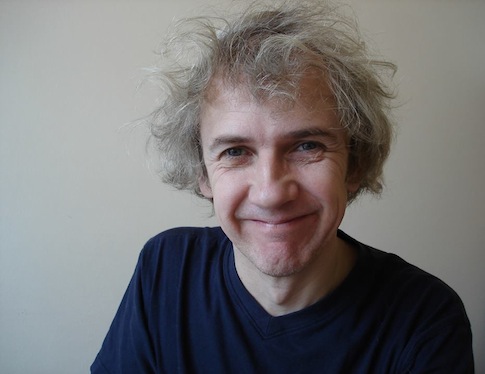
I meet with Mäetamm in his studio in Tallinna Kunstihoone. Vertically propped up against the wall is a painting that stretches from the floor to the ceiling – it is of a huge bookcase. Above the bookcase it states that these are all of the books that he, Mäetamm, has always wanted to read, but hasn't had the time. There are no titles on the bindings of the books, but Mäetamm tells me that many who have seen the painting give him a wink and say that they completely understand which books he has meant – even though it turns out that everyone has a completely different notion of what those books could be.
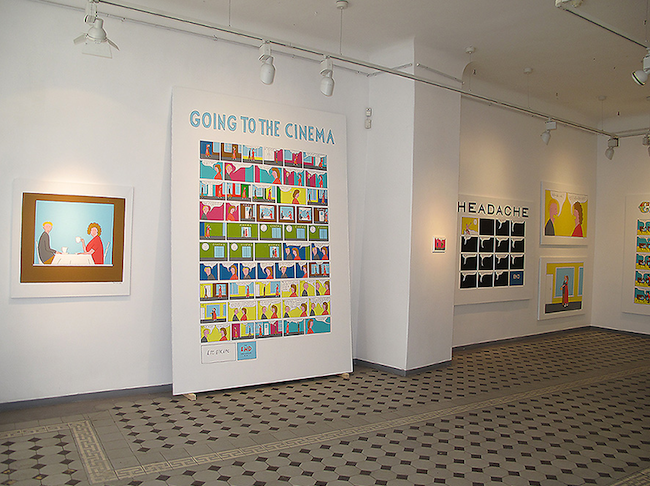
Exhibition Painting and Waiting at Draakon gallery in Tallinn. 2013
Why do you work in so many mediums?
I began as a print artist, but I soon realized that there was no point to it.
Why is there no point to print art?
I don't mean in an overall sense – just in terms of myself. I studied print art at the Tallinn Academy of Arts; I worked with lithographs. During my first years there, I just printed and printed. I printed about 150 color lithographs, without giving any thought about the role of the medium, or to similar issues. It was my field, I knew it well, and I just forged ahead. Until I was lucky to end up at a printmaking symposium in Sweden at the end of the 1990s. There I saw these “lithograph freaks” who had come from all over the world – they were so obsessed with the technical virtuosity of printmaking and with the self-serving reproduction capabilities of the medium, that the whole scene suddenly repulsed me. No one was talking about the ideas there. Only about the quality of the paper, the acids, the equipment and techniques – about everything that I had never given a second thought to. There is nothing bad about lithography, but I understood that it is not for me. I returned home to a lithograph that I had already started, and I never finished it. That was a radical step; I turned to the canvas after that.
Wasn't it hard to suddenly start painting?
No – I didn't change my approach, it was just the surface that changed. I have never painted... in a painterly sense. My works are always graphic, based on the line. I like to create, not busy myself with the technical aspects, which is why this transition from complex lithography to canvas actually freed me.
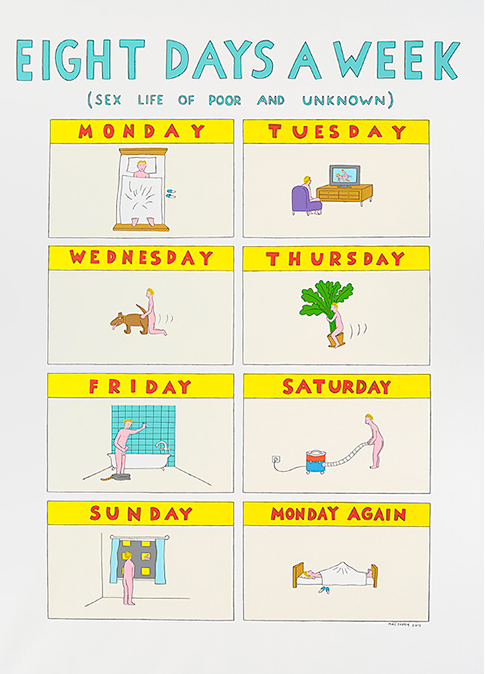
EIGHT DAYS A WEEK. 2 x 1.50 m. 2013
Why did you even major in print art?
When I came up with the idea of going to the Academy of Arts, I didn't know a thing about art. I was from a small place in southern Estonia where there wasn't any hint of the arts. But I suddenly saw my future self as a designer who would make furniture. My parents were rather perplexed about my going into the arts, but product design was the subject that sounded the most like a real job, and thus, the most valid choice for me. When I came home after the army, I applied to the Academy, but the competition was so strong that I wasn't accepted that first year. At the time, I didn't even have any long-term plans – I just wanted to get in. Thinking strategically, I gave up on getting into the painting department since it seemed that you needed additional skills for that; I didn't have any notion about sculpture, I can’t really think three-dimensionally. But printmaking was linked to drawing, which seemed like something simple, so I went with that. I was accepted on my second attempt. Once I was in, I happened to be in a really great graduating class, and I developed quite quickly.
On your webpage, there are four different stories about how you became an artist. Which is the real one?
All of them! I wrote them all because I couldn't decide which one was the most relevant. And it really is true that one of my strongest motivations for applying to the Academy of Arts was my breakup with girlfriend, who not only wasn't interested in art, but didn't even like it. That was my revenge – to become an artist! (Laughs)
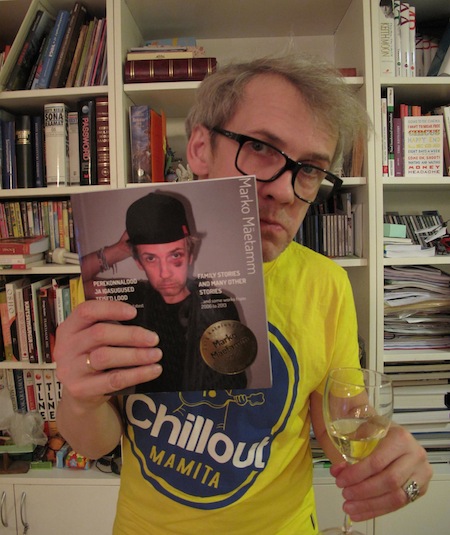
Marko Mäetamm with his latest catalog, fresh from the printing house. December 2013
What about the story in which, as a child, you had a bycicle accident and hit your head so strongly that not only did your hair begin to curl, but you also began to think about art...?
Yes, that's also the honest truth. The accident was very serious, and I believe it's left a permanent mark. Ironically enough, I had another biking accident last spring. That person on the cover of the catalog with a black eye and broken arm is me, just home from the hospital where I had lain for five days due to a compound fracture. My son immediately thought to take a picture of me, and I have his cap in the picture. I have a feeling that falls are sort of “my thing”. Some weeks ago I was going home after the opening of Kris Lemsalu's exhibition a the Temnikova & Kasel gallery. The sidewalks were covered in black ice, and as I walked home, I fell numerous times... I finally thought, how many times can one artist fall to the ground?! Like in that Bob Dylan song – “How many times...?”
Your works seem autobiographical – like diary entries. How documental, or fictional, are they?
What you're saying applies to my latest series of works, “Family Stories”, which have a grain of truth to them. The starting point for every story is some real event from my family's daily life, which I then take and develop further in my imagination – I play with various versions of “what would happen if I did this...” Someone once described my works as “life writing”, which is a contemporary approach to documenting – the artist writes about his life without letting go of the tether of truthfulness, but at the same time, changing some things around here and there.
It is vitally important to me to know that, as an artist, I have my feet on the ground, and that I'm talking about something that I have really experienced, or at least, have imagined as developing from a true-life event. Our dreams and nightmares are also a part of our reality.
How did you come to the realization that your works must be about your own family life?
It's more like the realization came to me. I didn't consciously choose it. In truth, it all started with a very vivid dream I had ten years ago. It was during the time when I had been offered the position of a dean at the Academy of Arts. Soon enough, my new job turned my life upside-down; I had jumped upon a treadmill that I could only escape from in the evenings – when I had to choose whether to spend this short amount of after-work time with my family, or go to my studio. I think a lot of artists go through this when they take a loan and have to pay it off by taking a steady job. And then I had this dream...
...the dream in which you kill your family so that you can completely devote yourself to art?
Yes, it was a real dream that I had while in Budapest, where I was setting up an exhibition. I'll show you (goes to a chest of drawers from which he removes a plastic-sheathed booklet that has been written upon). I keep this as proof of what happened that night – the booklet on which, as soon as I woke up, I wrote down the surprisingly vivid and realistic dream. It was extremely frightening. That morning I sat in my hotel room and thought: “Damn! My brain generated this. If I can come up with such a horrifying scenario in my subconscious, then I must be a monster!” The dream and its message came in one package – in the sense that I immediately understood that what I had just seen must be now embodied into a work of art.
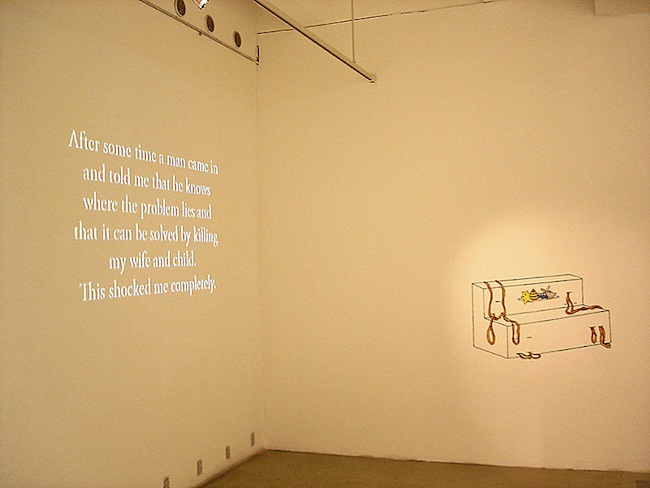
Exhibition Reading in Absence at Trafo Gallery in Budapest. 2005
When I returned home from Budapest, I told my wife about the dream. She didn't know how to react to this information; she just asked me if my life really is all that horrible. In thinking about how to embody the dream into a work of art, I resolved that I would write text, and thereby I would not directly portray any one member of my family. This dream, and its transference into a work of art, was definitely an important turning point for me – from then on, I understood the road that I should take in my work: I must speak about myself. I felt that everything that I had done before that was just the playing of a game, and that now I was finally working with something real. With something that had meaning. I even started looking at the works of other artists that I knew through this same sort of prism – how truthful are they in what they are doing? It suddenly seemed that this empty “playing around” with colors and shapes is just that – play-acting, without any real foundation.
Your family didn't have any objections to becoming the source material for your work?
At first, it was important to explain to the kids why, for instance, evil things are being shown in the videos or drawings; that I talk about things that worry me, and that using our faces is just a way to get the technical part done because I have to use somebody, and the simplest thing to do is to use pictures of them... But that's the way it really is! I asked my kids – who should I use, then? Somebody from the street? The children of my friends? That would be even weirder... In this case, my family is like an instrument that I use to tell a story. They are the characters through which I play out my ideas.
As the children grew, there came a day when they no longer wanted to be recognized through my works. My daughter began going to school and she didn't feel comfortable with it anymore, which is why I had to change my methods, and so now I use more anonymous faces. I still use my wife a lot, however. In my latest works, there are conversations with my wife.
What I've gained from this all is being in a constant state of awareness in my daily life, since everyday family events serve as the inspiration for my art. I don't zone-out, but rather, observe what is going on. In addition, if I decide to embody something in my work, I have to take into account that I will have to be able to explain to my family why it is that I'm doing it this way, and not some other way. So that the portraying of people who are close to me doesn't become a self-serving end in its own right. It keeps me on my toes, and it makes me think critically.
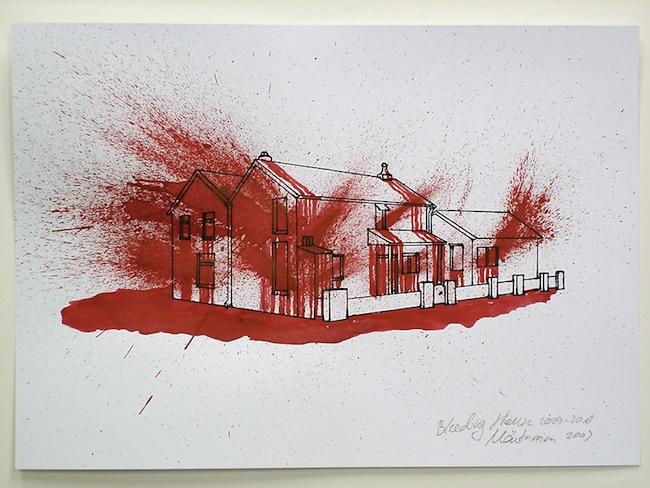
From the series of Bleeding Houses. 2009
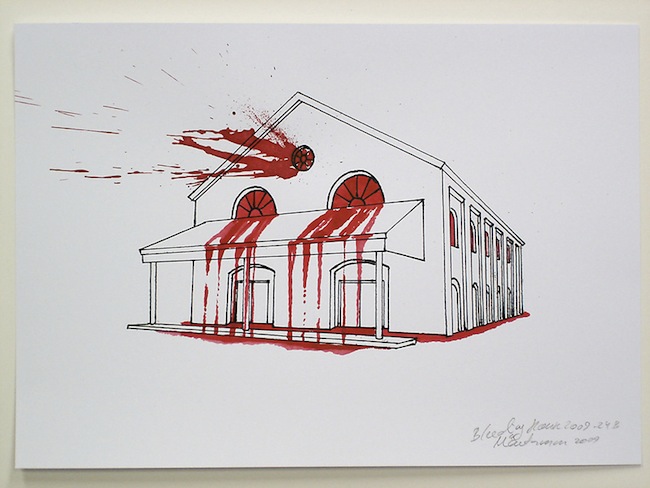
Along with your family, humor is another essential part of your work; in art, this usually isn't the easiest of things to include.
It isn't easy for me either, since I don't even use humor! (Laughs) I never do it intentionally. When I started making art, it really upset me that people laughed at it; I wasn't thinking about funny things while I was creating it – I was working seriously. The subjects didn't seem funny to me. I don't remember the exact year when I began receiving invitations to comics festivals. I angrily threw them away because I had never read comics, and I certainly don't make them! Every artist yearns to be taken seriously. I really struggled to come to terms with this sort of reaction. I hated it. I increasingly delved into dark subjects and would then portray them in my works; but to other people, they became even funnier. In one exhibition, I wrote the Ten Commandments on something similar to road signs: don't do this, don't do that. I thought – now this is really serious. The first visitor to the exhibition came in as I was still setting it up, and he said: “You are so funny! I can't stop laughing!” In the end, I just gave in, and I no longer worry about it. I know that I simply can't escape from it, that my works will always seem amusing to other people. I even take it into account now. One art critic wrote that the reason that my works are the way that they are, is simply because I have no sense of humor and bad taste.
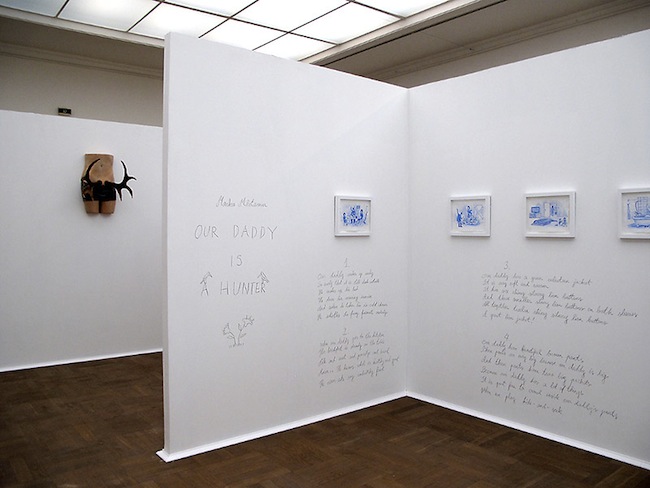
Works from the series Our Dady is a Hunter (2011) at group show The Exotic in Tallinna Kunstihoone. 2012
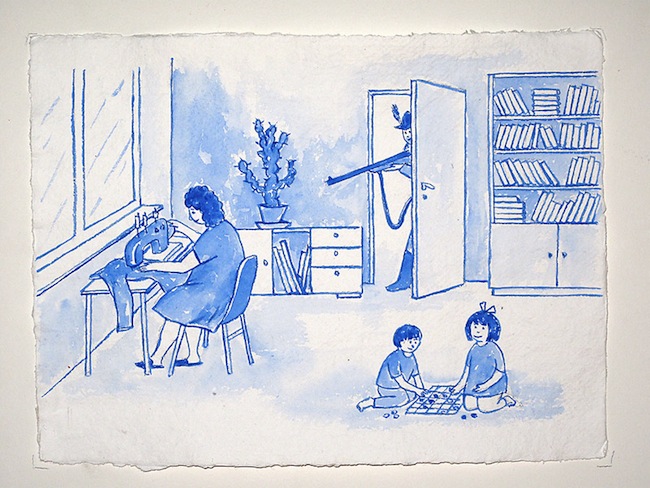
When did you begin writing on the walls? This isn't anything new in art overall, but I'm wondering as to why you chose to do it, if you could just as well print the accompanying text on paper.
I had an exhibition in London in which I included the aforementioned short stories, the ones about how I became an artist. We had prepared prints of them all, except for one – because I didn't think we'd use it. On the morning of the opening, however, we decided that we do need it. Since there wasn't enough time, I simply wrote that story on the wall, and we concluded that it was even better! More down-to-earth, more personal and natural. Since this also happened to be very convenient, I started to use this method consistently. Regardless of the size of the gallery's wall, the text can always be sized to fit. It's also easier to transport the works because once the show is over, the text can simply be erased. You don't have to transport huge rolls of paper or canvas. It is, however, inconvenient from a commercial aspect, since the buyer ends up with handwriting on a wall instead of something physical. This did happen once, and I had to make an identical copy on a huge piece of paper. The buyer didn't want me to write on the wall of his home because if he moved, he couldn't take the piece with him. Since most of my artworks are accompanied by text, I believe I've found a really good means of executing that. I'm fascinated by the fact that it's not a real product, but more like urban graffiti in which you're simply sharing your thoughts.
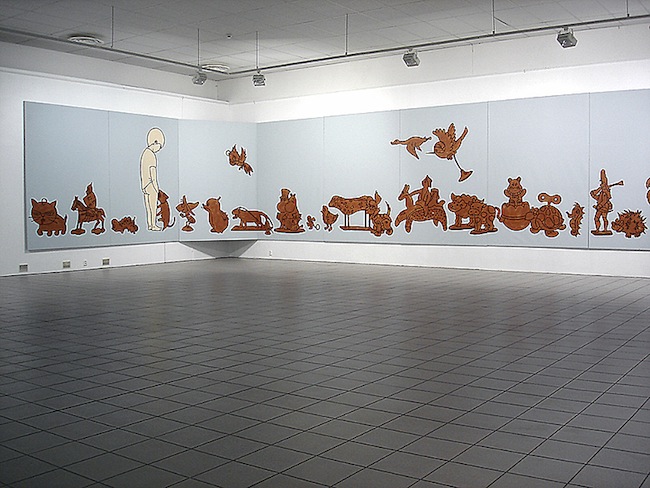
I give everything to my friends. I always do. 2005
But why is it important for you to use so much text? You've become a real storyteller.
In the beginning, the titles of my works were very, very long. I didn't even think that I could write something until I came to the realization that the titles had evolved into short stories. The reason behind this could be that the ideas started off in my head as word games, sentences, dialogs. The first vision I have is verbal, not visual. After that, I try to find the physical way in which to visualize the idea.
Is it necessary to also visualize the story? Why don't you just stick with the text?
It's an inner necessity. I can't imagine myself as a writer. I need this synthesis because I love to write stories, but I also feel the need to react to the text with something visual. The text is just the foundation with which to begin my work in the studio.
In the catalog I've also published texts that outline the context of how my works come to be. For example, what happened after I came home from the opening, or, the time my wallet was stolen. Details that don't seem to have any close connection to art, but in the end, turn out to be more connected than anything else. It was an interesting experience to put everything together and come to the realization that the works of art are actually illustrations of the twists and turns in my life. Writing about what happened during the creation of the work was an opportunity to draw vivid parallels that, to my eyes, gave another layer of meaning.
Art is a way in which I react to life – to my moods, to what I've experienced. This doesn't really apply to positive feelings because they simply don't inspire me to react. When everything is good, when you're happy, then everything is so pleasant that it isn't even necessary to go to the studio. That's awful, isn't it? I think about this almost every evening.
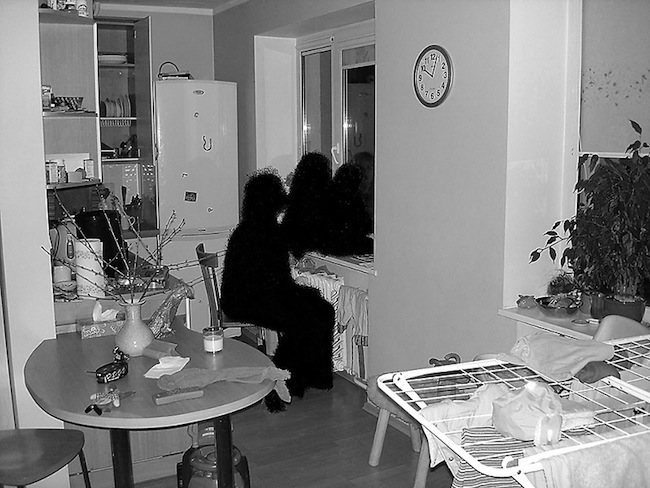
From the series Family Photos. 2005
A sad fate for a good artist. There's no room for happiness.
I'm convinced that it's punishment. To be an artist or creative person is, overall, punishment, and not a gift. I always tell my students – if there's anything else you'd like to do, please leave and do something else. There are all sorts of artists, of course, but most often it is a burden that the artist must carry – art will always be by your side, you'll never be able to get it out of your head. That's why the only people who can do art are those who have no other opportunity to do something else in life. People who simply cannot resist to be artists – for whom art is a lifeboat that they need to survive. If that's the case, then get to it and start expressing yourself! Doing art is like talking to yourself out loud. Several years ago, one of my former classmates had some mental problems that led to him walking around and talking out loud to himself. Later, once he was cured, he told me what it was like. The thoughts in his head were flying about at such a speed that the only way to follow them, and not get even crazier, was to speak one thought out loud. In my opinion, artists have a similar thing going on, and that's why they create. So they don't go crazy.
I take that you wouldn't want your children to become artists...?
I'd be happy if they did something else. But I wouldn't stand in their way if one of them came to the realization that they have no choice, that art is their only calling. Then you have to do it. Because the life of an artist is, of course, exciting, interesting and full of surprises. That's why, in a sense, I am happy that I have been given this strange fate – to be an artist. A monotonous, routine job would, most likely, destroy me. Although it does sound tempting, of course, to shut the door of your studio at five o'clock and go home to play with the kids, or take your wife to the movies. One can do all of this, but the art will always be in your head. You can never escape from the problems that you're trying to solve through your work.
What about the need to not only create, but to show your work? You could make it and then just leave it there, in your studio. Why does an artist exhibit his work?
Yes, that is interesting. I think there's a need for feedback. One needs to feel that someone is listening to you, and then replies to what you've said. That's what drives you to make exhibitions. Communication with the viewer is very important to me. If, as an artist, you don't have this need to publicly show your work, then you can't be a professional. Then it's just a hobby that you do for your own pleasure, and it's not working with art on a professional level. What's the point of having a phone in your pocket if you don't want to call anybody? I am convinced that art is a form of communication. I was extremely shy at school. They say that such children have a social phobia. I was panic-stricken that I might say something that was wrong. This sort of situation forces one to create your own language because there is so much that you want to say, but you just can't express it verbally. In teaching at the Academy, I've noticed that those people who are good at speaking – who are socially active – are not always the best artists because they say so much just through speaking. Of course, this is only a theory of mine.
But art is a secretive language that everyone can understand in their own way. How does that influence your communication with the viewer?
Yes, that is at the root of all of the disappointments that makes the life of an artist even sadder. (Laughs) That's exactly why the artistic profession can never be fully enjoyed – because you regularly end up having not been understood. The belief that a work of art doesn't have just one single meaning is a pain in the artist's ass. Because the language that you've developed, and which you speak through in your work – all with the hope of communicating – is truly only understood by just one person on this earth: yourself. The most ironic thing is that when you start to do art, you coddle the illusion that you will succeed at bringing your message across in a clear-enough manner. That you will be heard and understood correctly. But this sort of illusion must exist because that is what drives you develop a style, to continually evolve. To me, communication is the main thing in art. I don't see the point of having a conversation only with myself. But, of course, there are all sorts of artists and with differing views.
You are one of Estonia's most internationally renown artists. Which moment do you perceive as the one in which you broke out?
An artist always hopes that what he does is comprehensible on an international level, and tries not to connect himself exclusively to the local scene. The thought that your work would be understood only by one or two million Estonians, and no one else, would be disheartening. But at the same time, you can never know how international your language of expression is. Because it's not like a book that can be translated into another language, and you can be sure of it being understood. The language of art is international, but it also isn't, because the artist comes from a certain environment and culture.
My break-out came comparatively late. The turning point was my participation at the 2007 Venice Art Biennale – I learned a lot from it and consequently, I adopted a different scale of thinking. I saw how it really is quite natural to be in circulation. That in large part, it's not about what you make, but where you are. You simply have to be hardworking and accessible. That is extremely important. In the six months before the opening of the Venice Biennale, I was working in London, and the most important thing that I realized in those months was that I was able to see my place in the international scene. I understood how my ideas “sounded” outside of Estonia. That was a helpful experience, and the same goes for Venice. Before then, I hadn't really spent much energy on dividing myself between the local and international art scenes, but since 2007, I think only in terms of an international scale.
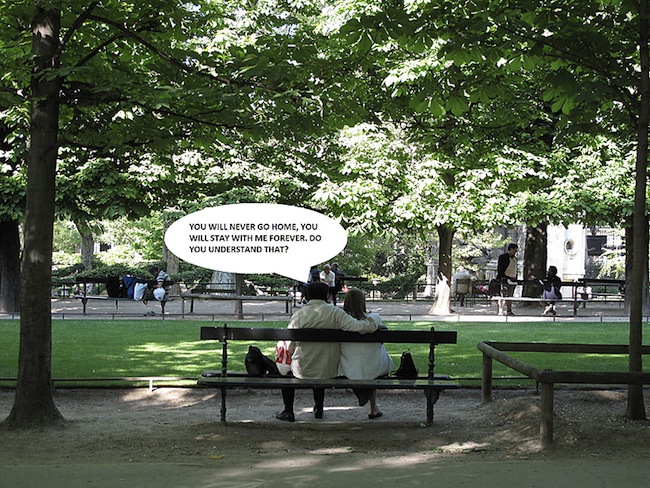
From the series Postcards from Paris. 2011
Why do you continue to live in Estonia?
I thought for a long time about moving somewhere else with the whole family. In truth, I still haven't completely thrown the idea aside. But ever since the kids started going to school, it's made everything a bit more complicated. In addition, I believe that if you have the ability to work on an international level without leaving your home country, then there is no reason to try and do everything in your power to integrate the whole family into a different culture. If I moved now, it would take a long time to fully adapt, and by then I'd already be old. It's not a bad thing to sometimes take a look at which country's passport you're holding. You shouldn't waste your best years attempting to build a new nest in some other corner of the world, and having to start everything anew again. But, as I said, I haven't completely abandoned the idea. Perhaps when the kids grow up and become independent, maybe then... (Laughs) But I do take advantage of opportunities to spend a few months in another environment, such as in residency programs, for example. I'll be blunt – working in Estonia is not exactly inspiring all of the time.
Where would you most like to move? London?
Yes, to London; or even better, to New York. Because the contemporary art scene there is so dense and vivid, and doing art is just as matter-of-course and important as any other profession. An artist doesn't have to continually justify himself there, whereas in Estonia, you sometimes feel as if you're banging your head against a wall – or in my case, slamming yourself into the ground. In addition, such a diverse art scene inspires me. In a local environment, every artist represents one position that is regarded to be the top one during a new exhibition; until, that is, it's replaced by another position which, in turn, becomes the “right” one. God forbid if two artists do something similar. Every artist has his own territory which others cannot enter. This isn't a problem in the hive that is New York. It's the exact opposite there – you have people who have the same views as you. For example, I'm often known in Estonia as the artist that kills of his family members in his art. Consequently, no one else does anything like that. But I can imagine that in the States there could be an exhibition featuring several artists who kill off their families in their art. That's wonderful! In much the same way, collectors on the outside also seem more open. At last year's Istanbul Art Fair, my ceramic book was bought by a Turkish man who only collects artworks that have to do with books.
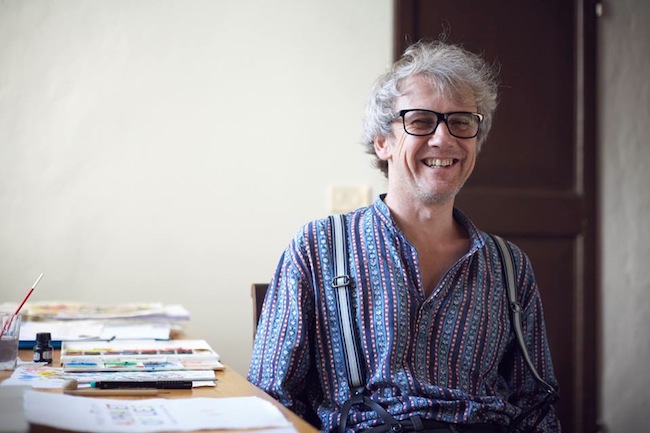
Photo by Michele Panduri Metalli
Back when I spent six months in London, a friend told me: “When you're away from home, your ideas grow bigger. When you work in a local environment, your ideas begin to shrink.” That's true – at home, you know your audience too well, and you're able to figure out what you have to do to look good. Which, in turn, gives you the false sense of being on top of things. What my friend said was proven true when I returned home – all of the ideas that had seemed really great to me in London suddenly looked too crazy, and so I abandoned them.